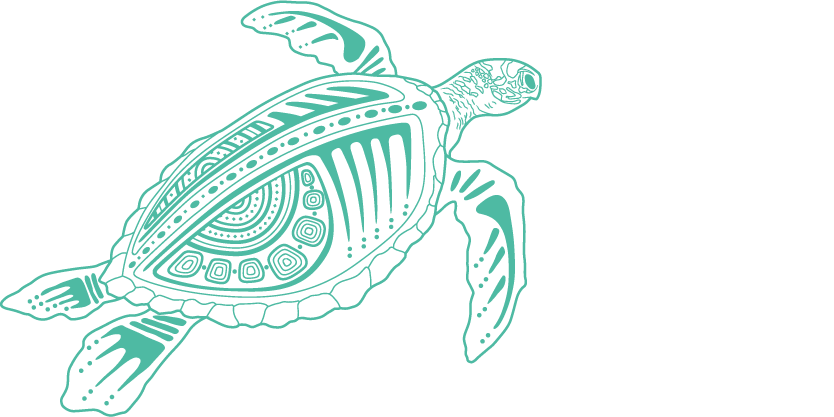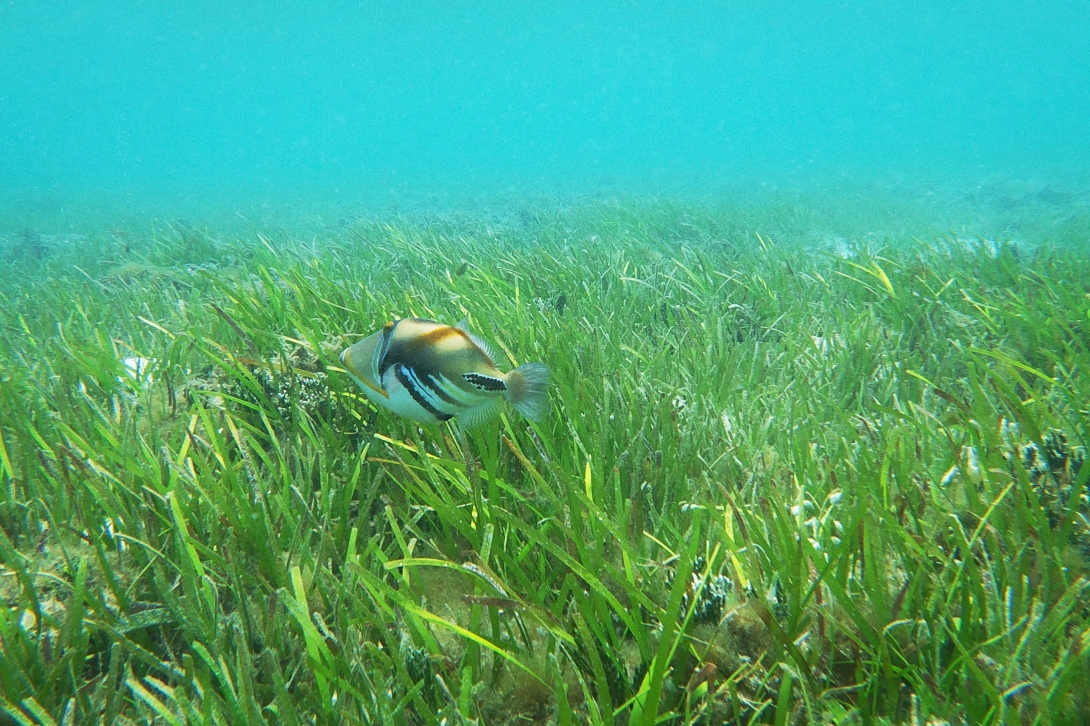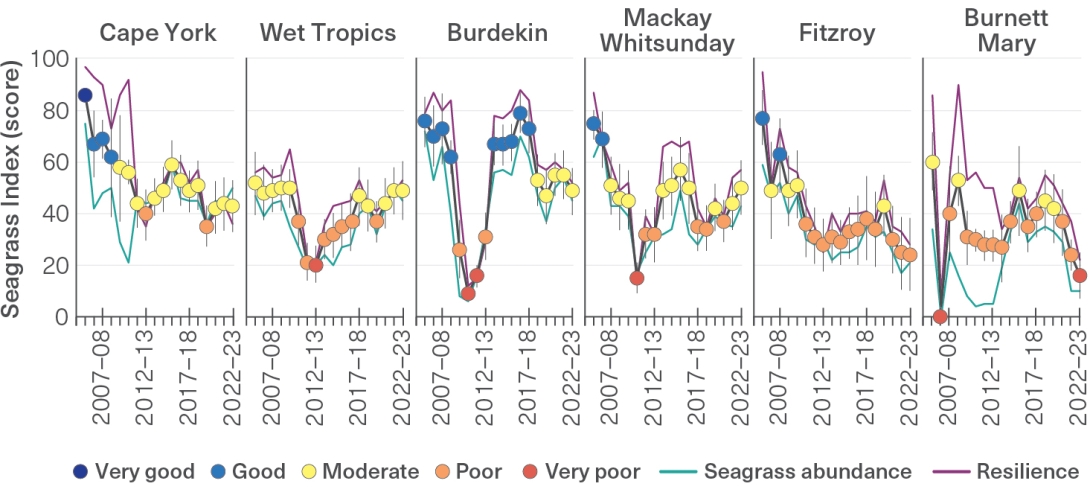42.
Waterhouse, J., Pineda, M., Sambrook, K., Newlands, M., McKenzie, L., et al. 2024, 2022 Scientific Consensus Statement: Conclusions, in 2022 Scientific Consensus Statement on land-based impacts on Great Barrier Reef water quality and ecosystem condition, eds J. Waterhouse, M. Pineda and K. Sambrook, Commonwealth of Australia and Queensland Government.
-
-
130.
McKenzie, L., Pineda, M., Grech, A. and Thompson, A. 2024, 2022 Scientific Consensus Statement: Summary | Evidence Statement for Question 1.2/1.3/2.1: What is the extent and condition of Great Barrier Reef ecosystems, and what are the primary threats to their health? in 2022 Scientific Consensus Statement on land-based impacts on Great Barrier Reef water quality and ecosystem condition, eds J. Waterhouse, M. Pineda and K. Sambrook, Commonwealth of Australia and Queensland Government.
131.
Paul, M. 2018, The protection of sandy shores–can we afford to ignore the contribution of seagrass? Marine Pollution Bulletin 134: 152-159.
132.
Burkholder, J.M., Tomasko, D.A. and Touchette, B.W. 2007, Seagrasses and eutrophication, Journal of Experimental Marine Biology and Ecology 350(1-2): 46-72.
133.
York, P.H., Macreadie, P.I. and Rasheed, M.A. 2018, Blue Carbon stocks of Great Barrier Reef deep-water seagrasses, Biology Letters 14(12): 20180529.
134.
Lavery, P.S., Mateo, M., Serrano, O. and Rozaimi, M. 2013, Variability in the Carbon Storage of Seagrass Habitats and Its Implications for Global Estimates of Blue Carbon Ecosystem Service, PloS One 8(9): e73748.
135.
McKenzie, L.J., Nordlund, L.M., Jones, B.L., Cullen-Unsworth, L.C., Roelfsema, C., et al. 2020, The global distribution of seagrass meadows, Environmental Research Letters 15(7): 074041.
136.
Heck Jr, K.L., Hays, G. and Orth, R.J. 2003, Critical evaluation of the nursery role hypothesis for seagrass meadows, Marine Ecology Progress Series 253: 123-136.
137.
Saenger, P., Gartside, D. and Funge-Smith, S. 2013, A review of mangrove and seagrass ecosystems and their linkage to fisheries and fisheries management, Food and Agriculture Organization of the United Nations Regional Office for Asia and the Pacific, Bangkok.
138.
Robblee, M.B. and Zieman, J.C. 1984, Diel variation in the fish fauna of a tropical seagrass feeding ground, Bulletin of Marine Science 34(3): 335-345.
139.
Heck, K.L., Carruthers, T.J., Duarte, C.M., Hughes, A.R., Kendrick, G., et al. 2008, Trophic transfers from seagrass meadows subsidize diverse marine and terrestrial consumers, Ecosystems 11: 1198-1210.
140.
Hayes, M.A., McClure, E.C., York, P.H., Jinks, K.I., Rasheed, M.A., et al. 2020, The differential importance of deep and shallow seagrass to nekton assemblages of the Great Barrier Reef, Diversity 12(8): 292.
141.
Marsh, H., O'Shea, T.J. and Reynolds III, J.E. 2011, Ecology and conservation of the Sirenia: dugongs and manatees, Cambridge University Press, Cambridge.
142.
Scott, A.L., York, P.H. and Rasheed, M.A. 2021, Herbivory has a major influence on structure and condition of a Great Barrier Reef subtropical seagrass meadow, Estuaries and Coasts 44(2): 506-521.
143.
Tol, S.J., Jarvis, J.C., York, P.H., Grech, A., Congdon, B.C., et al. 2017, Long distance biotic dispersal of tropical seagrass seeds by marine mega-herbivores, Scientific Reports 7(1): 4458.
144.
Carruthers, T.J.B., Dennison, W.C., Longstaff, B., Waycott, M., Abal, E.G., et al. 2002, Seagrass habitats of northeast Australia: Models of key processes and controls, Bulletin of Marine Science 71(3): 1153-1169.
145.
McKenzie, L.J., Collier, C.J., Langlois, L.A. and Yoshida, R.L. 2023, Marine Monitoring Program: annual report for inshore seagrass monitoring 2021–22. Report for the Great Barrier Reef Marine Park Authority, Great Barrier Reef Marine Park Authority, Townsville.
146.
Carter, A.B., McKenna, S.A., Rasheed, M.A., Collier, C., McKenzie, L., et al. 2021, Synthesizing 35 years of seagrass spatial data from the Great Barrier Reef World Heritage Area, Queensland, Australia, Limnology and Oceanography Letters 6(4): 216-226.
147.
Coles, R., McKenzie, L., De’ath, G., Roelofs, A. and Lee Long, W. 2009, Spatial distribution of deepwater seagrass in the inter-reef lagoon of the Great Barrier Reef World Heritage Area, Marine Ecology Progress Series 392: 57-68.
148.
Rasheed, M.A., McKenna, S.A., Carter, A.B. and Coles, R.G. 2014, Contrasting recovery of shallow and deep water seagrass communities following climate associated losses in tropical north Queensland, Australia, Marine Pollution Bulletin 83(2): 491-499.
149.
McKenzie, L.J., Collier, C.J., Langlois, L.A., Yoshida, R.L. 2024, Marine Monitoring Program: Annual report for inshore seagrass monitoring 2022–23. Report for the Great Barrier Reef Marine Park Authority, Great Barrier Reef Marine Park Authority, Townsville.
150.
Collier, C.J., Langlois, L., Waycott, M., McKenzie, L.J. 2021, Resilience in practice: development of a seagrass resilience metric for the Great Barrier Reef Marine Monitoring Program, Great Barrier Reef Marine Park Authority, Townsville.




